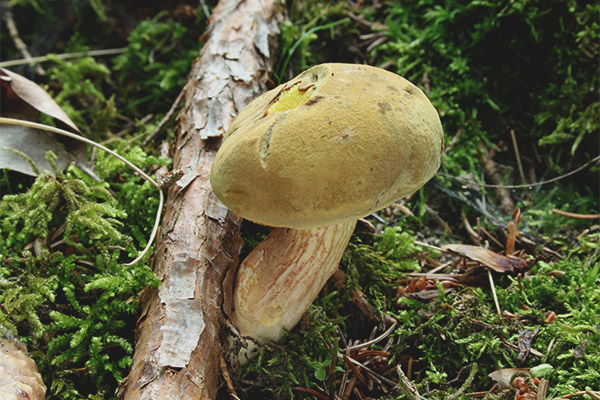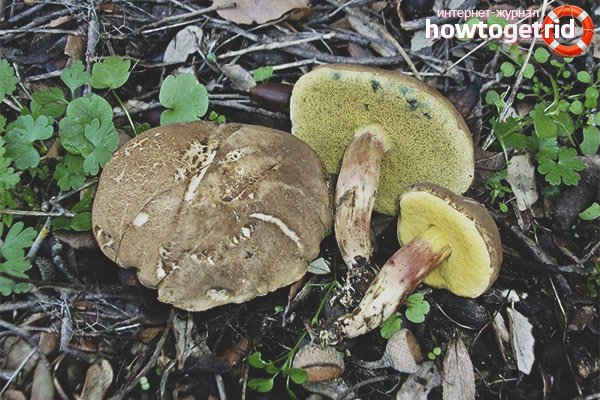The content of the article
The name of the presented species of the fungus has a rather primitive origin. Mokhovik is called this way because it prefers to grow alongside moss. Also, each species has a postscript, be it a red or green flywheel. We are interested in the second option, today we will consider it in detail. It is important to know where it prefers to grow and when fruiting begins.
Description
- Refers to edible type, proportional in format, consisting of a base and top (a hat). In height fruit bodies vary from 3 to 11 cm.
- The diameter of the apex ranges from 4 to 20 cm. The surface of the hat is dry and velvety. If it has recently rained or growth occurs in a wet environment, the upper part becomes sticky.
- The color of the hat may be brownish or dark green.Young specimens can boast a sticky top, and old mushrooms have a flat hat. It may crack if the mushroom overrips or dries. The skin is soft, poorly separated or not separated at all.
- The soft part is compacted like cotton wool. On a shade yellowish with greens, it can be red. When the cut is observed characteristic blue pigment. Reproduction is carried out by spores of brown, brown or olive hue.
- Base on cylinder format. At the bottom there is a seal that tapers towards the hat. Leg smooth, with wrinkles and ribs, may be covered with a grid. The diameter ranges from 1 to 4 cm.
Sprouting
- They are found in different climatic zones and regions. Distributed in Russia, North America, North Africa, Asia, Australia. Most of the fruit bodies are found in areas with moderate climatic conditions.
- They build a symbiosis with moss of different species. Also mycorrhiza can be observed with coniferous or deciduous trees. Preference is given to spruce, pine, beech trees, chestnuts, lindens.
- As for the territory and the specific place of growth, it is necessary to look for representatives of this species in former anthills, on forest edges, in meadow parts, on stumps, dead trees.
- Difficulties in gathering definitely exist. They grow alone, so the colony can not be found. We'll have to try to collect the basket.
- Love sandy soil. Gathering can be practiced since May, ending in September or October. Most often found together with Polish mushrooms.
Green flywheel
- Such fruit bodies are among the most popular and sought after of their kind. Considered mushrooms are quite common. Such fruits can be easily recognized thanks to the golden-brown color of the cap. At the same time its diameter can reach 10 cm.
- In such mushrooms, the cap has a cushion and prostrate shape. In this case, the leg of the fruit is painted in greenish color. It has a cylindrical shape that expands closer to the base. The leg can be up to 9 cm high. The thickness is about 3 cm.
- If you compare the color of the legs with a cap, then the first one is lighter. Also noticeable is a brick reddish hue.The flesh of the fruit bodies under consideration is rather dense, while it is colored white. But if you cut it, you will see that it turns blue.
- Often, green Mokhoviki are found in open meadows, in forests and near roads. Instances in most cases begin to bear fruit from late spring to mid-autumn. Such mushrooms can easily fry, pickle, cook and freeze. Consider, the fruits in question are not dried, they turn black.
Red Mohovik
- The presented fruit bodies became known to many precisely because of their characteristic color. In addition, each experienced mushroom picker knows where to find such specimens. You can easily find the mushrooms in question mainly in deciduous forests.
- In addition, the fruits are often found among the low grass and moss. The hat has the same pillow shape. At the same time, its diameter can reach 8 cm. Thickness is about 1 cm. Under the cap, the leg has a yellow color. Closer to the base, it acquires a crimson color.
- In the fruit bodies under consideration, the flesh is colored yellowish, while it has a rather dense structure.Often, mushrooms begin to bear fruit from late summer to mid-autumn. Red mokhoviki have a pleasant aroma. Mushroom pickers advise to cook them immediately after collection. Fruit storage is not suitable.
Presented fruit bodies are quite widespread. These mushrooms are popular around the world. The specimens are quite palatable and have a classic mushroom flavor. As for cooking, it is better to take this in the first day after collection.
Video: Green Moss (Xerocomus subtomentosus)












To send